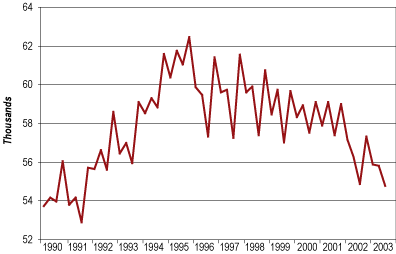Muncie
Directorm Economic and Policy Studies, College of Business, Ball State University, Muncie
The recession of 2001 may have been one of the mildest on record for the national economy, but try telling that to a Muncie area business, particularly in manufacturing. The two-year long cratering of business spending nationwide, now seemingly at an end, produced empty order books and worried faces for countless companies. The result has been a bump down amidst the slow decline the Muncie economy has experienced since the midpoint of the last decade.
Total employment bore the brunt of the recession in the latter half of 2001 and the first half of 2002, when year-over-year job losses topped out at about 4.7 percent (see Figure 1). Since that time, the job total has essentially remained constant. Indeed, in the first ten months of 2003, the 1.1 percent decline in Muncie’s job base was better than half of Indiana’s other metropolitan areas (MSAs).
Figure 1
Muncie’s Total Employment, 1990 to 2003

The event that contributed the most to the downward dip in employment was the closing of Burlington Motor Carriers. In the early 1990s, employment in transportation and warehousing in Muncie averaged about 4,000 jobs, peaking as high as 6,500 jobs in 1995. Now those industries account for only about 1,000 jobs, with nearly 2,000 of that total loss occurring in the beginning of 2002.
When combined with the slow attrition in other manufacturing jobs, this amounts to a 1,500 job loss in total manufacturing employment since 2000. This was more than could be offset by job growth in services industry employment, which has continued to grow. Education and health services, and professional services employment, in particular, have continued to grow throughout the economic downturn.
The different directions of change in the goods and services-producing segments of the economy in recent years have produced a remarkable result: Delaware County is now the most diversified economy in east central Indiana, with a significantly lower fraction of its employment base in manufacturing than any of its neighbors, as well as the state.
However, It is also an economy, as Figure 1 demonstrates, that has been in a slow decline for almost a decade. There are some rays of sunlight through all this darkness, however.
In the last several years, an awareness that new engines of economic growth were needed for the local economy culminated in the launching of a new economic development effort that placed emphasis on technology and knowledge-intensive industries. Ball State University has played a higher profile role in economic development than in the past, with a business incubator, contributions to venture capital funds, and large increases in external funding for research accomplishments to date from its efforts.
Those seeds may bear fruit in the near future, but households and businesses in the meantime must operate in the economy of the present. Certainly, an acceleration in the national economy will help the Muncie economy, but our experience of the last ten years tells us that it will take more than that for us to prosper.
Also in this Issue…
- Outlook for 2004
- The U.S. Economy
- The International Economy
- Financial Forecast
- Corporate Governance and Reporting
- Housing
- Indiana
- Anderson
- Bloomington
- Columbus
- Evansville
- Fort Wayne
- Gary
- Indianapolis
- Kokomo
- Lafayette
- Muncie
- New Albany
- Richmond
- South Bend/Mishawaka and Elkhart/Goshen
- Terre Haute
- Outlook Summary for 2004



